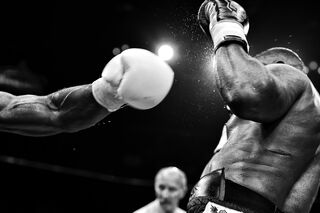Anger
Sports, Rivalry, and the Psychology of Controlled Fury
Can anger be channeled into a competitive advantage?
Posted September 14, 2021 Reviewed by Ekua Hagan
Key points
- Anger can be harnessed for positive benefit, especially within the realm of sports.
- Like other intense emotions, anger can lead people to lose focus and act impulsively.
- The term "controlled fury" represents the ideal balance necessary to use anger effectively.
Anger is a strange emotion. It generally feels unpleasant, but at the same time, motivates us to act in ways that may be necessary given the situation.
As we've seen, anger goes deeper. James Gandolfini teaches us that anger can also be intentionally cultivated; a special fuel to store up and use for the right occasion. And it turns out, he's not the only one who harnesses anger to their advantage.
In the world of sports, athletes apply this approach to great effect.
Closing pitchers in baseball, for example, know this all too well. Their job is simple: Come in for the last few outs of the game. Throw fire, strike everyone out, and close out the game. If there’s a role for a quick burst of anger anywhere in the sleepy doldrums of baseball, it’s there.

Closers have used a variety of tactics here. Hall of Famer Trevor Hoffman, for example, got into the mood with “Hell’s Bells” blasting in the home stadium every time he’d come into a game. Dodgers’ Kenley Jansen credits his improvement as a closer with learning how to get angry with himself over previous poor performances. “You have to be angry,” Jansen told MLB.com. “Enough is enough. Sometimes you just put a little more into it. You want to get better. Sometimes anger helps.”
But the award for most creative technique would go to Tampa Bay Devil Rays’ pitcher Tyler Glasnow. He has a specific picture on his phone which he only looks at right before he enters a game. It’s a picture of a person’s face: Convicted pharma Bro Martin Shkreli.
Anger is part of human nature and there are many ways of experiencing it. It’s important to highlight, however, that while anger can be a great source of motivation, it’s a mercurial fuel. In order to be used effectively, one needs to be able to harness it. Anger alone won’t result in improved performance, but instead, a kind of controlled fury.
The Psychology of Controlled Fury in Sports
Athletes in combat sports like boxing and MMA know this all too well. Anger comes naturally. When you’ve got a person across from you attempting bodily harm, you hardly need a pre-game cue. The skill comes from what one does with this response; the discipline needed over one’s emotional response. If one becomes too engulfed by their own anger, all technique is lost.

The knowledge of one’s opponent’s strengths and vulnerabilities, the footwork, the overall fight strategy, and above all—the defensive posturing, are subsumed by emotion when one “sees red."
This is why, of course, beyond the technical aspects, combat sports and martial arts place a premium on discipline. Mike Tyson, is arguably the best, and also the angriest, boxer of all time. He is the poster child for controlled fury: When he harnessed it, he was unbeatable.
But his lowest points—such as biting Evander Holyfield’s ear, were when his anger took the driver’s seat. Put simply, his career was defined by his ability or inability to harness his anger. He once remarked, “Emotion is more than just anger. When I am performing, I need emotion, but I need control, too. Emotion drives the best performance and is necessary, but it must be controlled.”

If we’re looking for examples of successful controlled fury in sports, we can do no better than The New Zealand National Rugby Team, The All Blacks. This is placed front and center in the fabled pre-match ritual: the Maori war cry known as the haka dance. You might think a group of 15 large, muscular rugby players is intimidating enough.
But the Haka Dance takes this to a different level. The team lines up, facing the opposing team with chests pushed forward, slapping their thighs, tongues outstretched, and unblinking eyes so intense as to almost bulge out of their heads. Imagine all the fury of a raging Tony Soprano, but harnessed into a coordinated dance. It’s an intimidating display of equal parts rage and discipline; the distillation of controlled fury.
Final Thoughts on the Psychology of Anger
Anger, like emotional guilt, is a mercurial force. We’re not always sure what kind of actions it’s going to produce, and how we’ll come to think about it later. Like all intense emotions, it can lead to impulsive decision-making and rash behavior. Learning how to understand it, and how to harness it, is key. Only then can we decide how we might want to cultivate it for a specific occasion.
To this end, there’s a lot we can learn from the world’s great practitioners of controlled fury. By studying their techniques, we can walk a mile in their shoes and adopt their approach. Until then, take a simple lesson from one of the pioneers of controlled fury, James Gandolfini: Before walking around in your own shoes, be sure to check them for small rocks.
This post also appeared on the human nature blog NeuroScience Of.
References
Cherry, M. E., & Flanagan, O. E. (2018). The moral psychology of anger. Rowman & Littlefield.
Itzkoff, D. (June, 2013). "James Gandolfini Is Dead at 51; a Complex Mob Boss in 'The Sopranos'". The New York Times.
Jordan, C (June, 2013). "In Jersey, Gandolfini remembered as regular guy". USA Today.
Newby, J. (Dec, 2020) Rays' Tyler Glasnow Used Picture of Martin Shkreli for Angry Motivation Prior to Games, PopCulture
NJ Spotlight News (June, 2013) James Gandolfini Was a Jersey Guy Who Helped Change Television, https://www.youtube.com/watch
Nussbaum, E. (June 20, 2013). "How Tony Soprano Changed Television". The New Yorker. Condé Nast. Archived from the original on June 17, 2020.
Martin, R. (February, 2021) How to be angry, Psyche Magazine
Parnell, D. (2014) Mike Tyson: "You Have To Feel Comfortable Being Uncomfortable.", Forbes
Toribo, J. (April 2021) 'Enough is enough' -- Jansen has new edge, MLB.com




